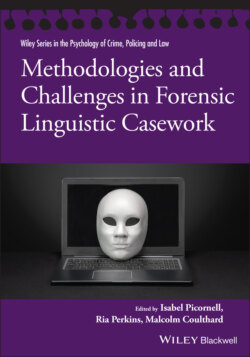Читать книгу Methodologies and Challenges in Forensic Linguistic Casework - Группа авторов - Страница 27
ATTRIBUTION
ОглавлениеAfter the known writings had been analyzed and JG had identified the feature set that distinguished between the known emails of Jamie and Debbie Starbuck, only then did TG pass to JG the remaining set of 29 potentially disputable emails. In this stage, JG went through each of the texts by hand and searched for each of the feature types systematically. As there were relatively few texts, and because a number of the features were difficult to search computationally, this process was primarily carried out by hand to ensure that no evidence was missed. For each text, the number of features that matched each author was recorded, and then the length of these lists and the nature of the features were considered to come to an attribution judgment.
In some emails, the evidence was mixed: it contained features associated with both Debbie’s and Jamie’s known styles. For example, some disputed emails contained some features associated with Debbie’s known emails—they were relatively long or started sentences with the word “And.” However, where these emails predominantly contained features associated with Jamie’s style, we still attributed the email to Jamie. If the mix was more balanced or if there were very few features in either direction, no attribution was made.
Overall, the feature set proved clear enough to attribute a substantial number of the texts across the timeline to Jamie Starbuck. For example, one of the most distinctive features was sentence length, as well as the way that longer sentences were constructed. In general, Debbie used considerably long sentences, including frequent use of sentence coordination and often run-on sentences linked with comma splices and dashes. Alternatively, Jamie often used short sentences, including one-word sentences, and very rarely run-on sentences (Table 2.1). These types of sentential patterns were far more common in the questioned documents offering strong evidence they were more likely to have been written by Jamie. Various other features associated strongly with Jamie’s writing samples were also present in these texts, including the deletion of apostrophes before the genitive marker in possessives, the use of highly informal features like interjections and emoticons, and the presence of several common compounded words including awhile, in between, and up-to-date, with those specific spellings.
However, perhaps the strongest evidence came from the closings of the known emails. Two patterns stood out. The first was that when Debbie had a two-line signoff (e.g., Lots of love, [line break] Debbie xxx). She would always put a single line break between them, whereas Jamie would always put a double line break in his two-line signoffs (e.g., Many thanks, [line break] [line break] Jamie). The emails which occurred later in the questioned series as provided by TG always contained double line breaks like Jamie’s and, indeed, the switch in this feature strongly coincided with other features to indicate the date of a shift in style. The second closing feature was that where Debbie generally signed off emails with “Debbie”, the questioned documents generally signed off as “Deb”, which was never used by Debbie in the known set but often was by Jamie in his own emails.
These two pieces of evidence clearly pointed to Jamie as the author of the questioned documents. The break point was indicated at the second email in the disputed group. Following this second email, that is to say by May 3, 2010, it appeared that Jamie alone was writing emails from Debbie’s account. This placed the date of the account takeover to be before the couple were supposed to have left the UK. This second email is particularly interesting as the first half contained features associated with Debbie’s identified style and the second half contained the closing features associated with Jamie’s previously identified style.
Further to this, scattered along the time series of disputed emails, a substantial number of texts could not be attributed on the basis of the feature set. This is primarily because they were too short and therefore did not contain any of the features identified. However, aside from the first two texts in the series, all of the texts were either clearly attributable to Jamie Starbuck or not attributable to either author due to lack evidence or mixed evidence. After May 3, 2010, we found no texts with features that were inconsistent with Jamie’s style.
Overall, we therefore found strong evidence that the style of the disputed emails from this date was substantially more similar to the style of Jamie’s known emails than to that of Debbie’s known emails, therefore clearly signaling that Jamie had taken over the account.
